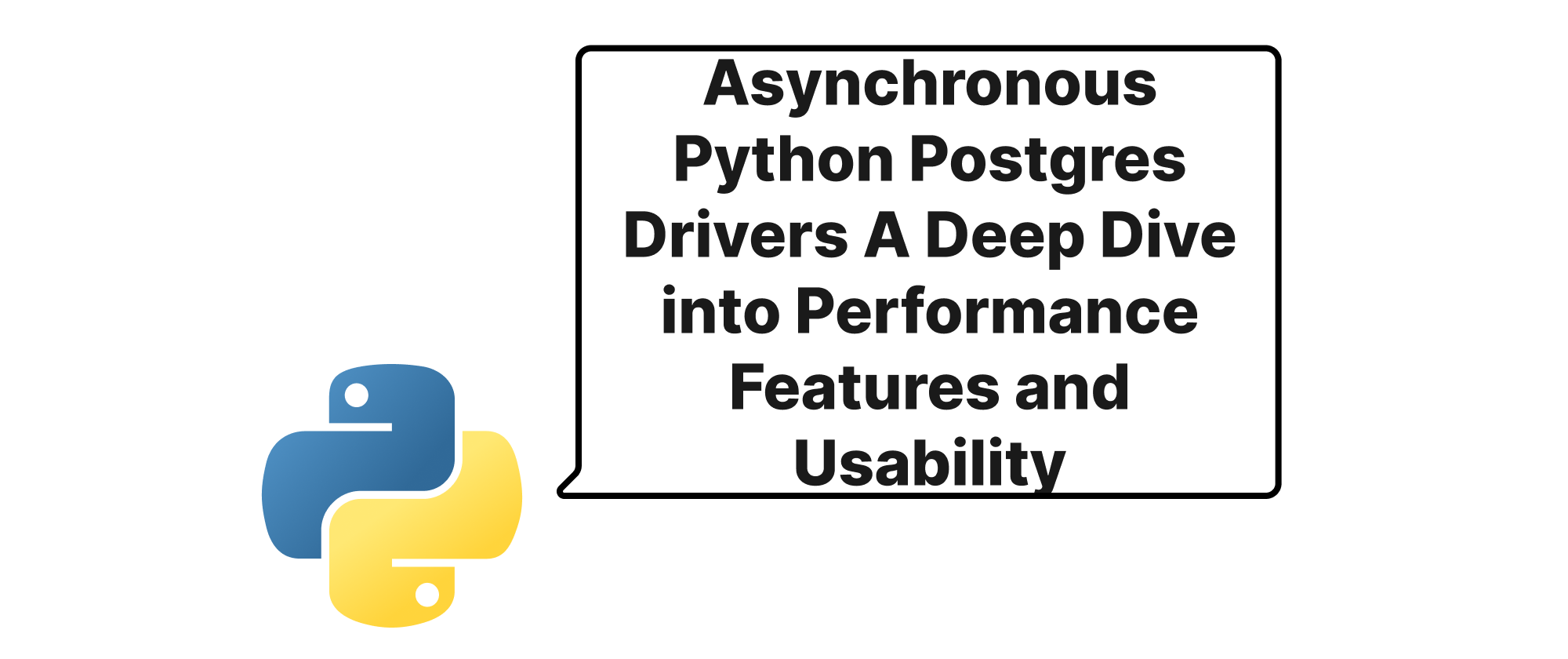Asynchronous Python Postgres Drivers A Deep Dive into Performance Features and Usability
Ethan Miller
Product Engineer · Leapcell

Introduction
In the world of modern web development and data-intensive applications, blocking I/O operations can severely bottleneck performance and scalability. This is especially true when interacting with databases, where network latency and disk operations can introduce significant delays. Python's asynchronous capabilities, particularly with asyncio, offer a powerful solution to this problem, allowing applications to handle multiple I/O-bound tasks concurrently without the overhead of threads. PostgreSQL, a robust and feature-rich relational database, is a popular choice for many projects. Consequently, the performance, features, and usability of asynchronous PostgreSQL drivers for Python are critical considerations for developers aiming to build high-performance, scalable systems. This article delves into a comparative analysis of the leading asynchronous PostgreSQL drivers, examining their strengths and weaknesses to help you make an informed decision for your next project.
Core Concepts Explained
Before we dive into the drivers themselves, let's establish a common understanding of some key terms that will underpin our discussion:
- Asynchronous Programming: A programming paradigm that allows a program to execute tasks concurrently without blocking the main thread. When an I/O operation (like a database query) is initiated, the program can "yield" control and work on other tasks until the I/O operation completes, dramatically improving efficiency for I/O-bound workloads. In Python, this is primarily achieved using the
asynciolibrary withasync/awaitsyntax. - Blocking I/O: When a program waits for an I/O operation (e.g., reading from a file, fetching data from a database) to complete before proceeding with the next instruction. This can lead to inefficient resource utilization if the program spends a significant amount of time waiting.
- Non-blocking I/O: An I/O operation that returns immediately, even if the requested data is not yet available, allowing the program to continue executing other tasks. The program can then check periodically or be notified when the data is ready. Asynchronous drivers utilize non-blocking I/O either directly or through underlying mechanisms.
- Connection Pool: A cache of database connections maintained by the application. Instead of opening and closing a connection for every request, applications borrow a connection from the pool and return it when finished. This significantly reduces the overhead associated with establishing new connections and improves overall performance.
- Transaction: A sequence of operations performed as a single logical unit of work. Transactions are atomic (all-or-nothing), consistent (database state remains valid), isolated (concurrent transactions don't interfere), and durable (committed changes persist). Asynchronous drivers must support proper transaction management.
- Prepared Statements: Pre-compiled SQL statements stored on the database server. They can be executed multiple times with different parameters, reducing parsing overhead and enhancing security by preventing SQL injection attacks.
Asynchronous Python Postgres Drivers in Focus
The Python ecosystem boasts several excellent asynchronous PostgreSQL drivers, with asyncpg and psycopg3 (specifically with its async adaptation) being the most prominent. Let's explore their characteristics, performance, and ease of use.
asyncpg
asyncpg is a dedicated asynchronous PostgreSQL client library built from the ground up for asyncio. It's renowned for its high performance and robust feature set.
Implementation and Principles:
asyncpg is implemented in C with a thin Python wrapper, allowing it to achieve exceptional speed. It uses the PostgreSQL binary protocol for communication, which is more efficient than text-based protocols. Its design prioritizes speed and asyncio integration, making it a very natural fit for asynchronous Python applications.
Key Features:
- Exceptional Performance: Often cited as the fastest Python PostgreSQL driver due to its C implementation and binary protocol usage.
- Rich Type Handling: Supports a wide range of PostgreSQL data types, including custom types, with efficient serialization and deserialization.
- Prepared Statements: Excellent support for prepared statements, automatically managing statement preparation and execution.
- Connection Pooling: Built-in, high-performance connection pooling.
- Copy Operations: Efficiently import/export large datasets using PostgreSQL's
COPYcommand. - Notifications: Supports PostgreSQL's
LISTEN/NOTIFYfor real-time eventing.
Example Usage:
import asyncpg import asyncio async def main(): # Establish a connection conn = await asyncpg.connect(user='user', password='password', database='mydatabase', host='127.0.0.1') try: # Create a table await conn.execute(''' CREATE TABLE IF NOT EXISTS users ( id serial PRIMARY KEY, name text, email text UNIQUE ) ''') # Insert data await conn.execute("INSERT INTO users(name, email) VALUES($1, $2)", 'Alice', 'alice@example.com') await conn.execute("INSERT INTO users(name, email) VALUES($1, $2)", 'Bob', 'bob@example.com') # Query data rows = await conn.fetch("SELECT id, name, email FROM users WHERE name LIKE $1", 'A%') print("Users starting with 'A':") for row in rows: print(f" ID: {row['id']}, Name: {row['name']}, Email: {row['email']}") # Using a transaction async with conn.transaction(): await conn.execute("INSERT INTO users(name, email) VALUES($1, $2)", 'Charlie', 'charlie@example.com') print("Charlie inserted within a transaction.") # If an error occurs here, Charlie would not be committed. finally: # Close the connection await conn.close() if __name__ == '__main__': asyncio.run(main())
Pros:
- Fastest performance among Python drivers.
- Idiomatic
asynciointegration. - Mature and widely adopted.
- Low-level control for advanced use cases.
Cons:
- Steeper learning curve compared to
psycopgfor users accustomed to synchronous drivers. - More verbose for simple operations due to its low-level nature.
- Specific to PostgreSQL, not a general-purpose database driver.
psycopg3 (async adaptation)
psycopg3 is the latest iteration of the psycopg family, a well-established and highly respected PostgreSQL adapter for Python. Unlike its predecessors, psycopg3 was designed from the ground up with asynchronous capabilities, offering a unified driver for both synchronous and asynchronous operations.
Implementation and Principles:
psycopg3 is written entirely in Python, using libpq (the PostgreSQL C client library) for low-level communication. It provides separate psycopg.Connection and psycopg.AsyncConnection classes, allowing developers to choose between synchronous and asynchronous modes without switching libraries. Its design focuses on flexibility, extensibility, and modern Python features.
Key Features:
- Unified Driver: Supports both synchronous and asynchronous modes with a consistent API.
- Type Adaptations: Highly customizable type adaptation system, allowing seamless conversion between Python and PostgreSQL types.
- Connection Pooling: Provides an asynchronous connection pool (
psycopg_pool.AsyncConnectionPool). - Composable Queries: Excellent support for constructing complex queries safely.
- Server-Side Cursors: Efficiently process large result sets without loading them entirely into memory.
- Compatibility: Aims for broad compatibility with various PostgreSQL features and extensions.
Example Usage:
import psycopg import asyncio from psycopg_pool import AsyncConnectionPool DB_CONFIG = "host=127.0.0.1 dbname=mydatabase user=user password=password" async def main_psycopg(): async with AsyncConnectionPool(DB_CONFIG) as pool: async with pool.connection() as conn: # Note: in psycopg3, cursors are typically used for execution and fetching async with conn.cursor() as cur: # Create a table await cur.execute(''' CREATE TABLE IF NOT EXISTS products ( id serial PRIMARY KEY, name text, price numeric ) ''') # Insert data await cur.execute("INSERT INTO products(name, price) VALUES(%s, %s)", ('Laptop', 1200.00)) await cur.execute("INSERT INTO products(name, price) VALUES(%s, %s)", ('Mouse', 25.50)) # Query data await cur.execute("SELECT id, name, price FROM products WHERE price > %s", (100,)) print("Products costing more than $100:") for record in await cur.fetchall(): print(f" ID: {record[0]}, Name: {record[1]}, Price: {record[2]}") # Using a transaction async with conn.transaction(): await cur.execute("INSERT INTO products(name, price) VALUES(%s, %s)", ('Keyboard', 75.00)) print("Keyboard inserted within a transaction.") # An error here would prevent the commit. print("All operations (psycopg3) completed and connections returned to pool.") if __name__ == '__main__': asyncio.run(main_psycopg())
Pros:
- Unified API for both synchronous and asynchronous operations.
- Highly extensible with strong type adaptation.
- Modern Pythonic design and excellent documentation.
- Robust features including server-side cursors and advanced query building.
- Familiar syntax for those coming from
psycopg2.
Cons:
- Generally slightly slower than
asyncpgin raw benchmark tests due to being Python-native, though often negligible for most applications. asyncfeatures were added later, making some patterns less "async-native" thanasyncpg's from-the-ground-up approach.
Performance Comparison
When discussing performance, it's crucial to acknowledge that benchmarks can vary significantly based on hardware, database configuration, query complexity, and connection pooling strategies. However, general consensus and various independent benchmarks suggest:
- Raw Throughput (Simple Queries):
asyncpgtypically holds an edge overpsycopg3due to its C implementation and binary protocol optimization. For extremely high-volume, simple queries,asyncpgcan offer noticeable benefits. - Complex Queries & Data Types: The difference tends to narrow for more complex queries, especially if significant time is spent on database processing rather than driver overhead. Both drivers handle various data types efficiently.
- Connection Pooling: Both drivers offer efficient connection pooling mechanisms, which are paramount for high-performance applications. The overhead of establishing a new connection dwarfs individual query execution time, so a well-managed connection pool is critical.
- Real-world Applications: For most typical web applications, the performance difference between
asyncpgandpsycopg3might not be the primary bottleneck. Application logic, ORM overhead, and network latency often have a greater impact. The choice often comes down to other factors like API design and extensibility.
Conclusion
Both asyncpg and psycopg3 are excellent choices for asynchronous PostgreSQL access in Python, offering robust features and impressive performance. asyncpg shines with its raw speed and deeply asyncio-native design, making it ideal for the most performance-critical applications where every millisecond counts. psycopg3, on the other hand, offers a more Pythonic experience, a unified API for both synchronous and asynchronous use cases, and exceptional extensibility, making it a highly versatile choice for a broader range of projects. Ultimately, the "best" driver depends on your project's specific needs, performance requirements, and team's familiarity with each library's API design. For absolute maximum performance and direct asyncio integration, asyncpg is the top contender; for a modern, flexible, and feature-rich driver with a unified API, psycopg3 provides a compelling alternative.


